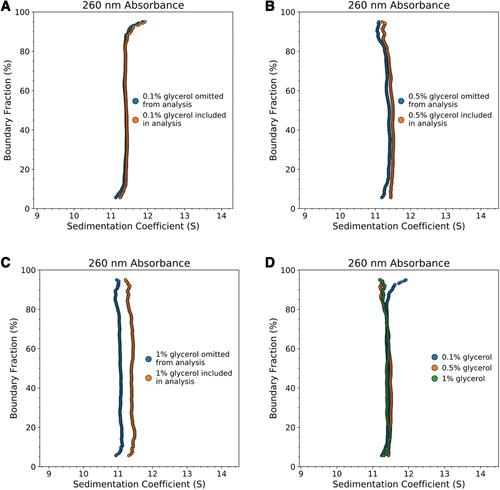{"title":"Analytical Ultracentrifugation (AUC): An Overview of the Application of Fluorescence and Absorbance AUC to the Study of Biological Macromolecules","authors":"Garrett B. Edwards, Uma M. Muthurajan, Samuel Bowerman, Karolin Luger","doi":"10.1002/cpmb.131","DOIUrl":null,"url":null,"abstract":"<p>The biochemical and biophysical investigation of proteins, nucleic acids, and the assemblies that they form yields essential information to understand complex systems. Analytical ultracentrifugation (AUC) represents a broadly applicable and information-rich method for investigating macromolecular characteristics such as size, shape, stoichiometry, and binding properties, all in the true solution-state environment that is lacking in most orthogonal methods. Despite this, AUC remains underutilized relative to its capabilities and potential in the fields of biochemistry and molecular biology. Although there has been a rapid development of computing power and AUC analysis tools in this millennium, fewer advancements have occurred in development of new applications of the technique, leaving these powerful instruments underappreciated and underused in many research institutes. With AUC previously limited to absorbance and Rayleigh interference optics, the addition of fluorescence detection systems has greatly enhanced the applicability of AUC to macromolecular systems that are traditionally difficult to characterize. This overview provides a resource for novices, highlighting the potential of AUC and encouraging its use in their research, as well as for current users, who may benefit from our experience. We discuss the strengths of fluorescence-detected AUC and demonstrate the power of even simple AUC experiments to answer practical and fundamental questions about biophysical properties of macromolecular assemblies. We address the development and utility of AUC, explore experimental design considerations, present case studies investigating properties of biological macromolecules that are of common interest to researchers, and review popular analysis approaches. © 2020 The Authors.</p>","PeriodicalId":10734,"journal":{"name":"Current Protocols in Molecular Biology","volume":"133 1","pages":""},"PeriodicalIF":0.0000,"publicationDate":"2020-12-22","publicationTypes":"Journal Article","fieldsOfStudy":null,"isOpenAccess":false,"openAccessPdf":"https://sci-hub-pdf.com/10.1002/cpmb.131","citationCount":"10","resultStr":null,"platform":"Semanticscholar","paperid":null,"PeriodicalName":"Current Protocols in Molecular Biology","FirstCategoryId":"1085","ListUrlMain":"https://onlinelibrary.wiley.com/doi/10.1002/cpmb.131","RegionNum":0,"RegionCategory":null,"ArticlePicture":[],"TitleCN":null,"AbstractTextCN":null,"PMCID":null,"EPubDate":"","PubModel":"","JCR":"Q2","JCRName":"Biochemistry, Genetics and Molecular Biology","Score":null,"Total":0}
引用次数: 10
Abstract
The biochemical and biophysical investigation of proteins, nucleic acids, and the assemblies that they form yields essential information to understand complex systems. Analytical ultracentrifugation (AUC) represents a broadly applicable and information-rich method for investigating macromolecular characteristics such as size, shape, stoichiometry, and binding properties, all in the true solution-state environment that is lacking in most orthogonal methods. Despite this, AUC remains underutilized relative to its capabilities and potential in the fields of biochemistry and molecular biology. Although there has been a rapid development of computing power and AUC analysis tools in this millennium, fewer advancements have occurred in development of new applications of the technique, leaving these powerful instruments underappreciated and underused in many research institutes. With AUC previously limited to absorbance and Rayleigh interference optics, the addition of fluorescence detection systems has greatly enhanced the applicability of AUC to macromolecular systems that are traditionally difficult to characterize. This overview provides a resource for novices, highlighting the potential of AUC and encouraging its use in their research, as well as for current users, who may benefit from our experience. We discuss the strengths of fluorescence-detected AUC and demonstrate the power of even simple AUC experiments to answer practical and fundamental questions about biophysical properties of macromolecular assemblies. We address the development and utility of AUC, explore experimental design considerations, present case studies investigating properties of biological macromolecules that are of common interest to researchers, and review popular analysis approaches. © 2020 The Authors.

分析性超离心(AUC):荧光和吸光度AUC在生物大分子研究中的应用综述
对蛋白质、核酸和它们组成的组装体进行生化和生物物理研究,为理解复杂系统提供了必要的信息。分析超离心(AUC)代表了一种广泛适用和信息丰富的方法,用于研究大分子特征,如大小,形状,化学计量和结合特性,所有这些都在真实的溶液状态环境中,这是大多数正交方法所缺乏的。尽管如此,相对于其在生物化学和分子生物学领域的能力和潜力,AUC仍未得到充分利用。尽管在这一千年中,计算能力和AUC分析工具得到了快速发展,但在开发该技术的新应用方面却取得了较少的进展,使这些强大的工具在许多研究机构中没有得到充分的重视和利用。由于AUC以前仅限于吸光度和瑞利干涉光学,荧光检测系统的加入大大增强了AUC对传统上难以表征的大分子系统的适用性。这个概述为新手提供了一个资源,突出了AUC的潜力,并鼓励在他们的研究中使用它,也为当前用户提供了一个资源,他们可能会从我们的经验中受益。我们讨论了荧光检测AUC的优势,并展示了即使是简单的AUC实验也能回答有关大分子组装物生物物理性质的实际和基本问题。我们讨论了AUC的发展和应用,探讨了实验设计的考虑,提出了研究人员共同感兴趣的生物大分子特性的案例研究,并回顾了流行的分析方法。©2020作者。
本文章由计算机程序翻译,如有差异,请以英文原文为准。



